Text
Uncle Hinti's Tips and Thirsty Suitors Update on Steam!
youtube
Thanks to everyone who's played and shared their love for Thirsty Suitors. We're launching a significant update for the game today, alongside a 20% Winter Sale discount. We hope you'll check it out! Full Patch Notes:
Added a new difficulty setting, Extra Hot, which will be selectable from the start of a save file. We recommend trying Extra Hot, as this new "Hard" mode makes encounters more engaging, items more useful, and pacing better.
Added 4 weaknesses to "Paati Suitor" battles, meaning less guesswork and quicker pacing during these random encounters.
Summons now have a cost, improving pacing across combat.
Random "Paati Suitor" battle intros and outros will no longer repeat within the same day.
Battle line orders have been changed to surface more fun ones.
Cooking step feedback has been improved to cut down on repetition and more frequently show shorter feedback lines on repeated cooking sessions for each dish.
Items and summons are now locked out during a particular story-critical battle in order to improve pacing.
Fixed a bug with Tyler's Day 3 conversation breaking.
Fixed a health clamp issue causing issues during a major story-critical battle.
If you haven't had a chance to check out Thirsty Suitors, it's 20% off during Winter Sale.
7 notes
·
View notes
Text
Finding the Beat: The Music of Thirsty Suitors
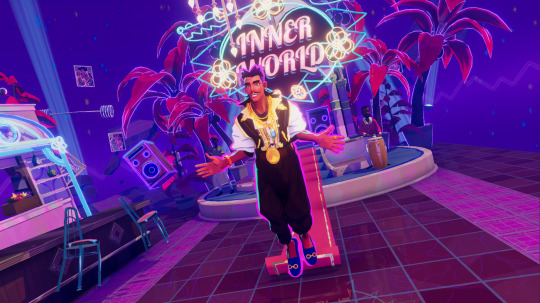
We’re continuing our deep dive into Thirsty Suitors by exploring the development of the music and sound design that you’ll hear while playing.
Thirsty Suitors has a colorful art direction and it only made sense for us to bring that same level of vibrancy into the music and sound of the game. We wanted our world to have a unique feel to it and you’ll hear a mixture of hip-hop, South Asian, and Carnatic influences throughout your time playing.
This week, our Composer, Ramsey Kharroubi, and Sound Designer, Anne-Marie Weber, talked about their approach to creating the unique sound for Thirsty Suitors.
The Inspiration for Thirsty Suitor’s Unique Sound
youtube
If you’ve been following Thirsty Suitors for any amount of time, you know there’s a lot of different elements at play. We have turn-based rpg battles, step-by-step cooking segments, and wild skateboarding areas for you to explore. With some many different experiences, we needed to make sure the music and sound effects complimented the eccentric gameplay.
Ramsey talked a bit about the key elements of the sound in the game, “I think percussion in general and as an instrument really embodies the sound of the game. The beat is always driving the soundtrack. Given the nature of the rhythm based gameplay with the cooking, skating and suitor encounters.”
He went on to explain how this percussive flair bleeds into the sound design as well, “The on screen actions are also denoted by percussive sfx courtesy of Anne-Marie, which appropriately complement the hectic music, which itself is using a lot of traditional South Asian instruments. Rhythm and percussion is an important instrument in South Asian and Arabic cultures and it’s something I relied on heavily here to design the aesthetic.”
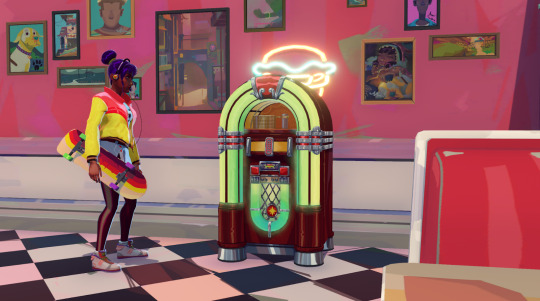
It’s safe to say that when you play Thirsty Suitors, you’ll be bobbing your head along to the wide-array of tracks in the game. In addition to great instrumental tracks, there are also a few songs in the game with vocals to accompany them.
We’re proud of what we achieved with these tracks. Here’s what Ramsey had to say about these songs, “It was a journey to find a vocalist who could sing in the Tamil language, do western vocals, and Carnatic singing. We had a few people reach out but nothing stuck. I’d say for almost half the project it felt like we were never going to find somebody,” Ramsey explained. “Suddenly we found Pri, or rather she found us and she ended up being great. She brings so much to the game's soundtrack.”
It’s no secret that in order to make the amazing games you love and play everyday, years of time is spent to bring them to life.
Throughout the time, many developers' lives change and morph and all of that is reflected in the work. “It’s amazing to me that during this game’s soundtrack gestation period I lived through a whole pandemic, moved from NY to WA, and experienced a number of different life events. The whole soundtrack feels chaotically similar to my life in that it’s a reflection of my own journeys.”
Finding the Right Balance
youtube
As with any avenue of game development, it’s not all sugar and rainbows. There are a number of challenges involved in creating anything for a video game. For the music and sound design in Thirsty Suitors there were a few places that Anne-Marie and Ramsey pointed to as interesting challenges for them to figure out during development.
Ramsey had this to say, “The balance between conversations, voice acting, and “battling” in the Suitor encounters was challenging. Making sure that the music flowed between the conversation bits and the action bits dynamically, and specifically accounting for voice acting including length of conversations was important to ensuring the whole game sounds better. Also encounters are locked in a certain tempo range of 100-120 bpm for player actions during battle to sync up with the music. Making sure the Suitor encounters were musically cohesive with the voice acting, narrative elements, and sfx was the most challenging aspect.”
What’ll you’ll find when you play through the game is a great balance between the vocals of the amazing voice cast we have alongside some of our music tracks that have vocals as well. These moments really elevate these battles while not becoming intrusive to the story unfolding in front of your eyes.
Anne-Marie agreed with Ramsey on some of these challenges, “While I've worked on a lot of other games before, it was my first time working on an RPG. In playtime it's actually one of the shorter games, but it still surprised me how large and complex it wound up being even within that smaller scope. There's a lot of bespoke work in each of the boss battles, and cooking as well.”
Channeling the Sound of the 90s
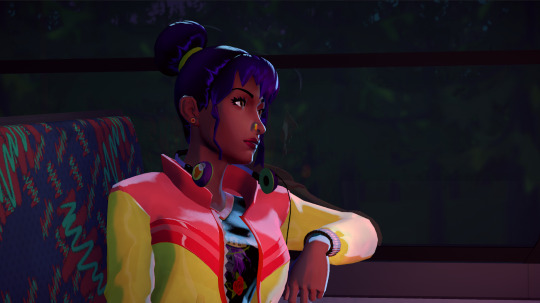
The world of Thirsty Suitors is largely inspired by 90s era aesthetics and vibes. You’ll see that the skateboarding elements of the game we talked about in a previous blog looked very similar to old skateboarding session videos of the time. You’ll also notice that our main character, Jala, goes everywhere with her trusty Walkman music player.
We wanted the music and sound of Thirsty Suitors to call back to some of these nostalgic nods from the time. Ramsey gave some insights into where the inspiration for the music in various locations in the game started.
“We felt a surreal version of late 90’s to early 2000’s music would fit Jala’s headspace the best. The game’s music is very much written from the perspective of Jala. So for me, being a child of the 90’s, the music I watched on MTV was my go to reference point. For example, the Skatepunk and the skatepark in the game are inspired by the Beastie Boys, which I’m a big fan of. Destiny’s Child, Garbage, TLC to name a few inspired some of the Suitor battles.”
There are much subtler ways that these sounds of the 90s and early 2000s work their way into the game. Anne-Marie spent a lot of time researching sounds of the era and incorporated fun sounds where she could. She told a fun anecdote about how Jala’s phone sounds came to be.

“Since the game is somewhat set in the 90s, it was the era of custom ringtones, so we made old school ringtones for each of the Suitors. I found my old Nokia 3310 and got it a fresh battery. Ramsey kindly provided me with some midis of the suitor themes, and with that I went and recreated them in the phone's composer, then played them back on the phone and recorded that for a super authentic sound. Really maybe it was just an excuse to revisit a bit of my childhood and play Snake again though.”
All throughout Thirsty Suitors–whether it's the music, sound, art, narrative, or gameplay–small nuggets like the anecdote above can be found. These personal touches are what bring the humanizing element to Thirsty Suitors and reflect the human hands that labored to make the game you’ll be enjoying very soon.
Ramsey had something to say about his general approach to creating music that speaks well to what we’re getting at in this blog:
“Music has the ability to bring worlds to life. For me as a composer, what excites me is to facilitate that aliveness, the intangible to the tangible, the abstract to the concrete, by creating a sonic language that appropriately fits the experience. I’m not saying I have succeeded every single time in doing that, but I always keep it in mind. I approach every piece like its own special project. Which means I want people to enjoy it outside the game as much as they enjoy it inside the game. So in regards to a game where everyone in all the disciplines has poured their hearts into and everyone truly believes in the project, players should know that a lot goes into every tiny aspect of its design and the intent is truly for memorable tunes.”
Game Development Tips
Anne-Marie and Ramsey both provided some tips for folks trying to get into sound design and music composition in games. Here’s what Anne-Mare had to say:
“Just get out there and start creating. There's so many online resources to learn anything you want these days, and so many free tools to start with. And once you have started making things, get out there and tell people about all the things you've learned, and learn from all of your peers doing the same process. Tools and techniques and processes are forever changing, and only by sharing does music and sound in games continue to reach new heights.”
Ramsey echoed a lot of Anne-Marie’s sentiments too, “If you’re passionate about music/sound in games and want to get involved, just start. Follow your dreams etc. There is a lot you’ll have to learn on your own unfortunately and nobody really shows you. That’s the main struggle, but there's ways to minimize it. Once you get the hang of it things get significantly easier to navigate.”
Outerloop Games Recommends
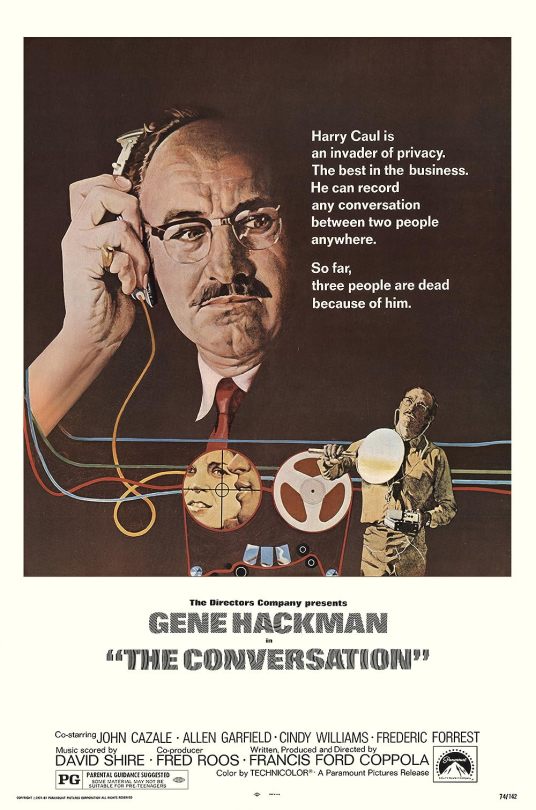
This week we asked Ramsey for a recommendation to give you all and he chose the 1974 Gene Hackman film, The Conversation.
Here’s what Ramsey had to say about it: “One of my all time favorite films is The Conversation with Gene Hackman, in which he plays a surveillance expert. The movie deals with themes of privacy, security and paranoia. It has a ton of attention to audio and sound and really blows me away how the audio is intertwined with the story and the script. The protagonist is also a musician within the movie and it’s really well done. I think as far as classic cinema is considered this one rarely gets a mention especially for how much it uses sound to tell its story.”
Thirsty Suitors Releases on November 2, 2023
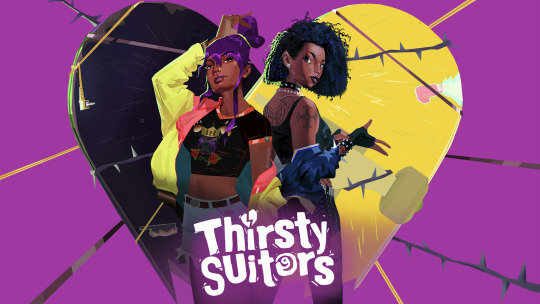
We recently announced our release date with a sizzling new trailer that we’re excited about. You can check it out below:
Trailer link: https://www.youtube.com/watch?v=4LIj46_R62M&t=4s
If you’re excited about Thirsty, we’d appreciate it if you Wishlisted the game on Steam, it helps put the game in front of more eyes.
Wishlist on steam https://store.steampowered.com/app/1617220/Thirsty_Suitors/?snr=1_5_1100__1100
You can also join our Discord, and follow us on Twitter @outerloopgames.
Thanks for reading, until next time!
18 notes
·
View notes
Text
The Perfect Line: The Origin of Skateboarding in Thirsty Suitors
We’re continuing our deep dive into Thirsty Suitors by exploring the development of skateboarding as a key pillar in the game.
Skateboarding in Thirsty Suitors is more than just how Jala gets around her hometown, Timber Hills. As with many of the systems in the game, we strived to make skateboarding function not only as a fun gameplay mechanic, but also a resonant narrative device.
This week, one of our animators and 3D artists, Aung Zaw Oo, talked about his connection to skateboarding and how he used his own skating skills to help implement it into the game.
Skate Your Heart Out

For many folks on the team, skateboarding brings up fond memories, whether we actually skated in real life or simply became high scorers in Tony Hawk’s Pro Skater there was something about skating and the culture that really drew us in.
Aung, however, has a much deeper connection to the sport. The work you see on the screen when you play Thirsty Suitors is also based on actual skateboarding and parkour tricks he can do in real life.
So, where did that connection to skating begin? Aung talked a bit about it, “I’ve been skating since 1997 when I was 15 years old. I was living in Singapore at the time and watched a heavily censored version of the movie Scream. There’s a throwaway scene at the high school where a skater ollies over a tiny curb…I’d never seen a proper ollie before. I’d only known of skateboarding being done on big ramps and such.”
Shortly after that, Aung bought a cheap skateboard at a local Toys R Us and after several weeks of practice, he learned to ollie and the rest is history.

Skateboarding culture can feel pretty all consuming, there’s a reason why skateboarding games have so many different dynamics at play from the actual skating, to the clothing, to building your own skateparks.
For Thirsty Suitors, we were more interested in exploring how skateboarding makes our characters feel and how they connect with others through the sport.
The Greatest Skater in the Land
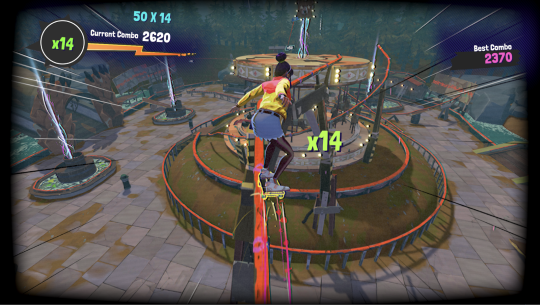
In the world of Thirsty Suitors, Jala was once the greatest skater in all of Timber Hills. When she left town with her then girlfriend (emphasis on then *cough*) a new generation of skaters rose up to replace her.

The only problem is they’ve come to fancy a creepy, cult-like leader by the name of Soundie–the old bear mascot for the abandoned amusement park outside of town called Bearfoot Park.
In addition to the drama associated with Jala reconciling with her exes and her family, she’ll also have to handle the situation brewing in the skatepark with Soundie.
Finding the Line: Bridging Gameplay and Narrative
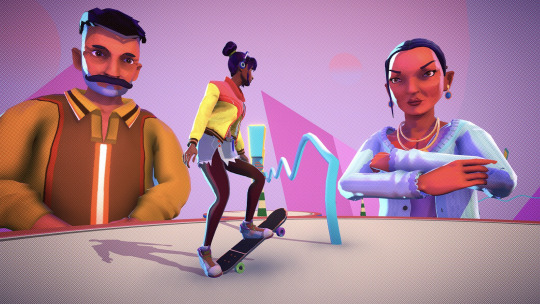
As we talked about earlier, finding the throughline between gameplay and narrative is always important to us when making games. We wanted Jala’s gameplay to be fun, but we also wanted it to resonate throughout the story and not just be mechanical.
This ethos starts with being intentional with how Jala and other characters engage with skating. “All of all the characters are very agile regardless of their age, shape or size ” Aung said.
Skateboarding wasn’t always narratively focused though. Like most things in game development, through trial and error and many iterations, we figured out how skateboarding functioned.
Throughout many of our games, skateboard animations have been present in some form or fashion. In Thirsty Suitors, skateboarding actually started out as a playable mini-game in our loading screens that resemble 90s skate videos. The only thing the player could actually do was move side to side and jump on rails to grind.
When our friends and families played the mini-game, there was so much excitement around it that we developed it into a full-fledged part of the game. This is one of the joys of making games, the process is fluid and possibilities are endless. One idea can grow and evolve into something much bigger right in front of your eyes. Figuring out how to scope these things properly and not over commit to every great idea is one of the double-edged sword aspects of development though.
We ended up finding an emotional through line between the gameplay of skating and what we wanted to tell in our narrative. We built out full 3D environments for Jala to skate around in. This became the main mode of transportation in the game. Then, little by little, we incorporated skate challenges and more that will put the player’s skills to the test.
Game Development Tips
Aung had a couple game development lessons he wanted to share for folks interested in animation.
Be comfortable with technical aspects of development. This is especially important in smaller teams where a team member has multiple roles. It also saves unnecessary work hours having to polish parts such as an animation settle frames that are gonna get chopped up or blended out in an animation behavior tree. Attention to detail is important but knowing which details can be skipped is equally important for not overworking yourself or your team.
Unlearn some animation principles. While traditional animation principles may apply to cutscenes, developing for gameplay is a different thing. For example, anticipation frames will feel like input lag to you which is a hard thing to zero in.
Have a deep cultural knowledge. Try to get a deeper understanding of the origin of a reference video or mocap data. Follow movement artists, acrobats, trickers, skaters, parkour practitioners and jugglers on social media. Currently instagram is the best place for that.
Outerloop Games Recommends

This week we asked Aung for a recommendation and he chose the 2003 sports anime, Kaleido Star.
The anime follows Sora Naegino, a Japanese girl, who travels to the United States to achieve her dream of performing at the world’s most famous acrobatic space, Kaleido Stage. Kaleido Star is created by Junichi Sato who is known for directing the first two seasons of Sailor Moon and a plethora of other acclaimed shows.
Aung recommends it if you’re interested in sports anime that are upbeat, tightly paced with no filler, and while it has some of the classic tropes of the genre, it does them very well.
Thirsty Suitors Releases on November 2, 2023

We recently announced our release date with a sizzling new trailer that we’re excited about. You can check it out below:
Trailer link: https://www.youtube.com/watch?v=4LIj46_R62M&t=4s
If you’re excited about Thirsty, we’d appreciate it if you Wishlisted the game on Steam, it helps put the game in front of more eyes.
Wishlist on steam https://store.steampowered.com/app/1617220/Thirsty_Suitors/?snr=1_5_1100__1100
You can also join our Discord, and follow us on Twitter @outerloopgames.
Thanks for reading, until next time!
9 notes
·
View notes
Text
An Appetizing Aesthetic: The Food of Thirsty Suitors
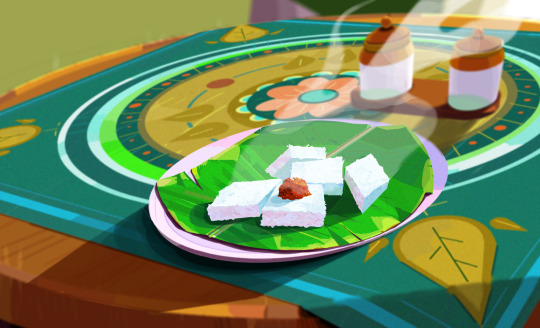
Last week, we talked about the evolution of how our cooking gameplay works in Thirsty Suitors and how the mechanics and narrative come together to help us tell Jala’s story.
We’re continuing further down the rabbit hole of food and cooking in Thirsty Suitors, this time by diving into the actual food you’ll see throughout the game.
Similar to the various forms of iteration that took place to get our Cooking sequences to where they are today, the same is true about the food.
Composing our Recipe Book
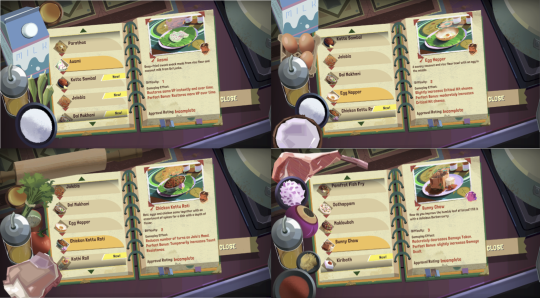
Thirsty Suitors has a variety of South Asian inspired dishes that all hold meaning for Jala, her family, and her exes.
We believe that food is more than just something that sustains us. What we eat also gives insight into our identities, where we come from, socioeconomics, history, and much more. In Jala’s family, her father, Arvind, is Sri Lankan, and her mother, Rukmini, is Indian.
So, Jala’s grown up with dishes from both countries and these two places compromise the majority of the cooked food you’ll make in Thirsty Suitors.
You’ll be able to cook 13 different South Asian inspired dishes throughout the game, each with their own unique story sequences related to the characters.
In our blog from last week, we talked about the evolution of cooking and our move away from making the act of cooking the recipes 100% accurate in favor of highlighting our narrative goals.
Our Art Department, however, has found unique ways of still making the recipes representative of their real world counterparts.

Take a look at the recipe book screenshots and you’ll see that in addition to the gorgeous paintings for each dish in the book, the ingredients on the left-hand side of the screen dynamically change to showcase key aspects of each recipe.
Creating an Appetizing Aesthetic
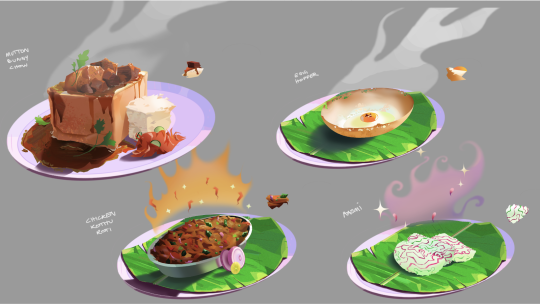
Creating great looking food is not an easy feat in any video game. A lot of time and iteration was spent throughout the development of Thirsty Suitors to land on the vibrant, graphic style in the game.
Our Art Director, Vijay Krish, talked a bit about how he approached creating the aesthetic for the food in the game. “First and foremost, the goal was to make the player hungry when they engaged in the cooking segments. Ideally, they’d want to eat the food at the end of every cooking challenge,” Vijay said.
But that isn’t as easy as you might think. Vijay and the team cast a wide net during the research of the various foods in the game to help with representing them in the best light possible:
“On one hand, we've got such rich source material for the various cultural dishes in the game. They’ve been perfected over many generations which by themselves makes them look visually stunning. On the other hand, Thirsty Suitors has an incredibly vivid palette and style we’re working within. The challenge was to combine the two and represent the food in such a way where the people who've grown up eating the dishes are able to relate to it. My intent was to represent them as faithfully as possible.”
Nailing the authenticity while also staying true to the exuberant artistic style we landed on for Thirsty Suitors was an interesting challenge. These constraints in design make you think more creatively and force you to find the “heart” of everything you’re making.

We see this idea even come through in the various cooking utensils you’ll use to make each recipe. While the dishes in Thirsty Suitors use a wide variety of cooking techniques and equipment, it wasn’t possible to include all of them.
We chose to approach this challenge by thinking about what were the key utensils we can highlight that speak to the soul of the dishes we’re representing, while also allowing us to create fun, over-the-top animations for Jala to perform.
The Final Dish
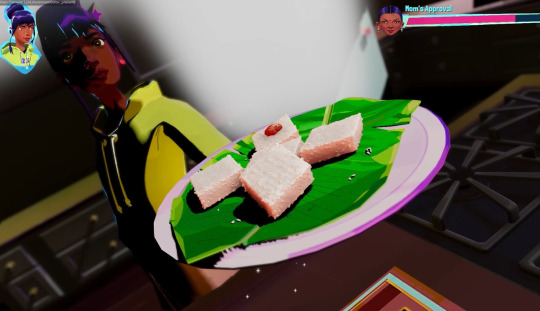
Another key element during the development of the food in Thirsty Suitors was nailing the look of the final dish.
At the end of each cooking gameplay sequence, Jala presents the final dish to her Mom or Dad for evaluation. Initially, we tried showcasing these dishes by modeling them in 3D, but doing so presented a number of challenges that you might underestimate in the creation of food in games.
Eventually, we realized that actually creating 2D illustrations opened up a much greater possibility space for our Art Department to experiment and achieve the results they were looking for.
Vijay shared some thoughts on this process too, “Initially our first iteration of what food would look like started with an illustration of Kiribath. When we took it to a full 3D render with the help of 3D assets from our incredibly talented Character Artist, Emma Koch, we realized we weren't able to control the shadows and the slight hue variations present in the dish to the extent in which we could in 2D.”
In addition to the challenges with shadows and hues, there was a process reason that also helped in making the decision to move to 2D.

Game development moves quickly and is very fluid, using 2D illustrations allowed the team to more more swiftly and streamlined the process overall to take the expertly composited 2D illustrations from our Creative Director, Chandana Ekanayake, and push them to the final versions present today.
Outerloop Games Recommends
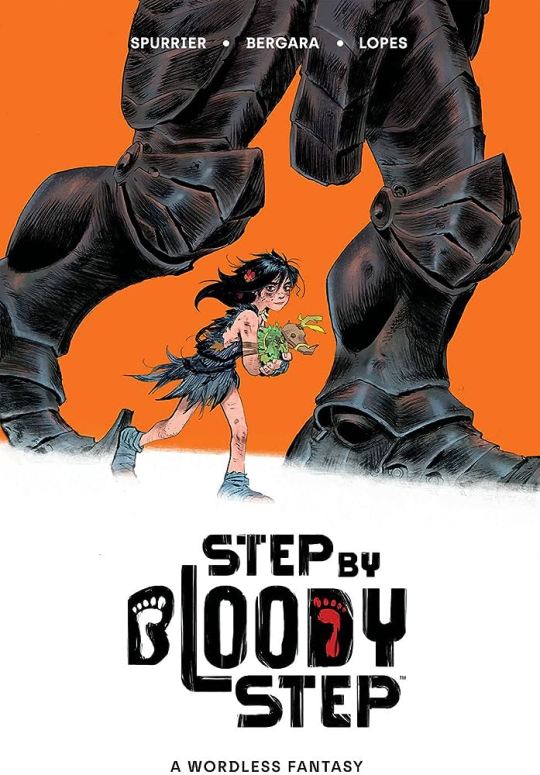
Step by Bloody Step
We asked Vijay to offer a recommendation to y'all this week, and what better than to highlight a work that is using it's visuals to tell a complex story.
One comic in particular keeps drawing him in Step By Bloody Step by Si Spurrier and Matias Bergara. The series follows armored giant guarding a helpless child through a dangerous overgrown world.
Vijay really appreciates Bergara's visual storytelling, and the entire 4 issue comic is told without the use of written words.
Thirsty Suitors Releases on November 2, 2023
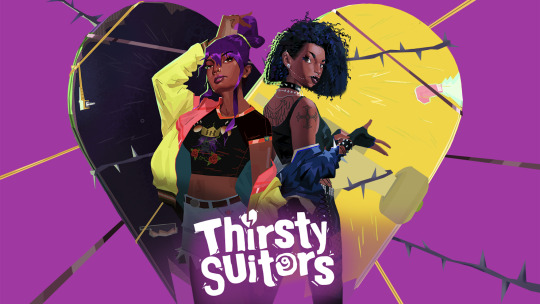
We recently announced our release date with a sizzling new trailer that we’re excited about. You can check it out below:
Trailer link: https://www.youtube.com/watch?v=4LIj46_R62M&t=4s
If you’re excited about Thirsty, we’d appreciate it if you Wishlisted the game on Steam, it helps put the game in front of more eyes.
Wishlist on steam https://store.steampowered.com/app/1617220/Thirsty_Suitors/?snr=1_5_1100__1100
You can also join our Discord, and follow us on Twitter @outerloopgames.
Thanks for reading, until next time!
16 notes
·
View notes
Text
Thirsty Suitors Dev Diary: A Recipe for Reconciliation
We recently announced that Thirsty Suitors will be releasing on November 2nd, 2023 for Xbox, PlayStation, Switch, and PC.
youtube
In the lead up to release, we’re going to dive into some key components of Thirsty Suitors, starting with a major element of the game: cooking!
In Thirsty Suitors, Jala must try and impress her Mom or Dad and repair their relationships through action-packed cooking segments that explore a rich menu of South Asian inspired dishes.
Cooking Together
youtube
The first recipe you learn in the game is how to make Parathas, a South Asian unleavened flatbread made with whole wheat.
Sounds easy enough, right? Wrong! Jala not only must make the dish, but navigate how she handles the tense relationship she has with her mom, Rukmini, after being absent for three years.

Each time you cook in Thirsty Suitors, you’ll need to open the cookbook on the kitchen table and choose the recipe you’d like to make.
The food Jala makes with her parents not only will help her repair their relationship, but it also affects the gameplay in our turn-based battles where Jala battles her exes and a variety of other eccentric characters in the game.
Making Food More than a Meal

Throughout the development of Thirsty Suitors, Cooking has evolved and changed to heighten the story we’re telling about Jala reconciling with her exes and repairing her relationship to her family.
While the main idea for the Cooking gameplay has stayed consistent–having Jala and her Mom cook recipes together through the player completing a series of quick-time events–the focus of how these sequences are presented and played out has expanded to help our narrative.
Here’s a look at the prototype phase for the Cooking gameplay in Thirsty Suitors. As you can see, we zeroed in on the general idea for how Cooking would work pretty early on with the player following a series of cooking steps in a recipe while Jala and her mom cooked.

A key difference from the prototype versus the final version of Cooking was the presentation and what we focus on.
Initially, the flow of these sequences had Jala’s Mom teaching her each step through demonstrating the action, and then the player would repeat what they watched, much like how you would in real life if someone was teaching you a recipe.
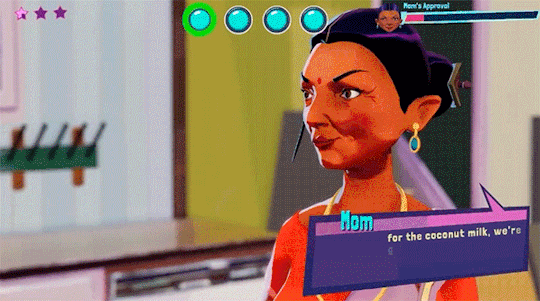
While it was cool watching the characters perform exaggerated cooking actions to complete each step, we found that the Cooking gameplay could interact more directly with the narrative.
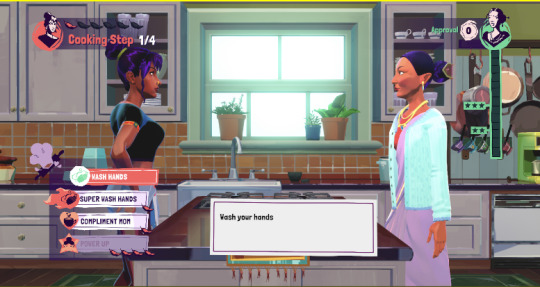
We decided to make these sequences less about making the dishes 100% accurately and more about what it means for Jala and her mom to cook together, and how it provides them an organic space to work through their issues and get to know each other again.
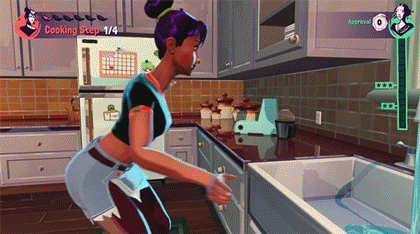
Part of the joy of making games–especially narratively focused ones–is figuring out how to create a perfect marriage between the mechanics you’re designing and the story you’re telling. In a perfect world, these two things are always in a balanced state.
Think of some of your favorite games out there, they didn’t start perfectly, instead, through years of iteration, teams figure out how to use the tools they’ve built to tell the stories they want in the best way they see fit.
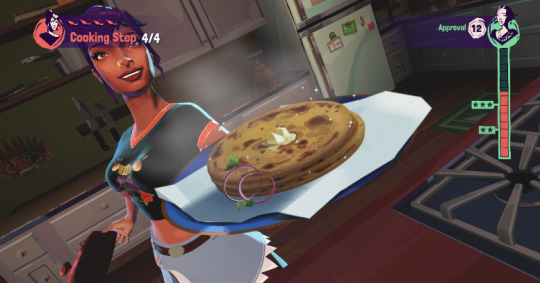
What we found is that by shifting the focus away from trying to create a perfect recreation of the South Asian inspired dishes we have in the game, we could focus more on the characters and what these dishes mean to them.
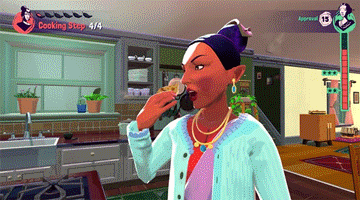
Outerloop Games Recommends
We’ve talked a lot about food, cooking, and how these things say so much about our identities, our families, and how we connect with others.
Luckily, we’re in a moment where there are some other games interested in exploring these themes as well. We’d like to highlight one in particular that resonates with us and also features South Asian characters called Venba.
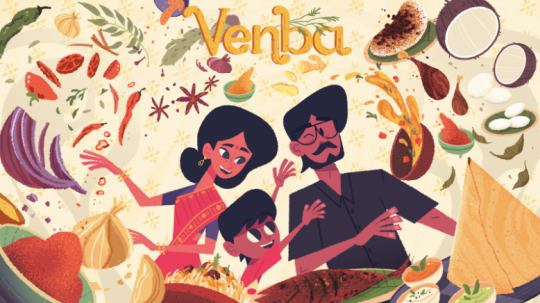
Venba is a narrative cooking game, where you play as an Indian immigrant mom, who immigrates to Canada with her family in the 1980s. Players will cook various dishes and restore lost recipes, hold branching conversations and explore in this story about family, love, loss and more.
While you’re waiting for Thirsty Suitors later this year, check out Venba on Xbox, PS5, Switch, and PC, out now.
There's More to Come
In the lead up to the release of Thirsty Suitors, we’ll continue to shed light on some of the many awesome aspects of the game, our team, and insights we’ve learned along the way.
If you’re excited about Thirsty, we’d appreciate it if you Wishlisted the game on Steam, it helps put the game in front of more eyes.
Wishlist on steam https://store.steampowered.com/app/1617220/Thirsty_Suitors/?snr=1_5_1100__1100
You can also join our Discord, and follow us on Twitter @outerloopgames.
Thanks for reading, until next time!
#Youtube#video games#thirsty suitors#xbox#playstation#steam games#south asian#srilanka#india#cooking
55 notes
·
View notes
Text
We’re Hiring: Unity Visual Effects Artist
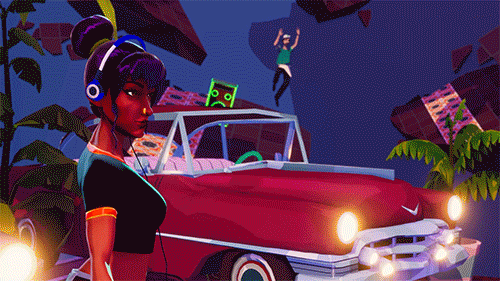
Outerloop Games is a minority led, fully distributed indie game studio that creates accessible games with depth about underrepresented cultures and themes. We are a small and diverse team of 14 people spread across four continents. We’re looking for an experienced Unity visual effects artist to join our team to help us with our current title Thirsty Suitors as well as future titles. Thirsty Suitors is a colorful cinematic RPG about battling your exes, disappointing your parents and finding yourself with turn-based battle mechanics, skateboard, cooking, and much more.
You’ll be creating stylized visual effects that convey the characters’ abilities and game mechanics, and environmental effects that bring the game’s surreal world to life. The ideal person will have a games industry background with experience in Unity particle systems, and the creation of VFX textures, meshes, animations and post processing effects. Familiarity with scripting and shaders would be a plus.
What you’ll be doing:
Creating stylized visual effects to convey the mechanics and theme of the game.
Collaborating closely with the art, design and programming teams to take the game’s visuals from concept to final quality.
Finding creative ways to add your own artistic skills into the game.
Requirements:
Experience working on VFX in Unity.
At least one shipped game title (preferably made with Unity).
Nice to Haves:
Experience creating shaders, either node-based (e.g. Shadergraph, Amplify) or custom coded.
Experience creating high quality VFX that are optimized for console or mobile platforms
Experience with 3D tools and animation
What we’ll be offering:
Competitive compensation
Four day 32 hour work week but paid for five days 40 hour work week
Opportunity to to contribute to and shape original work and IP
Personal and professional growth over the course of this project and future projects
Flexible and accommodating schedule
Please send your portfolio, resume, references, and anything else you think we should see to [email protected] with the title VFX Artist
7 notes
·
View notes
Text
Announcing our next game Thirsty Suitors
youtube
From Outerloop Games comes Thirsty Suitors - a game about culture, relationships, family pressures, and expressing oneself. Can Jala handle her demanding parents, reconcile with her exes, and mend broken friendships in time for her sister’s wedding? Will she be ready for the impending visit of Nani, the family’s terrifying and judgmental matriarch? Through the game’s story, Jala will confront her exes in cinematic, turn-based battle sequences.
Combat
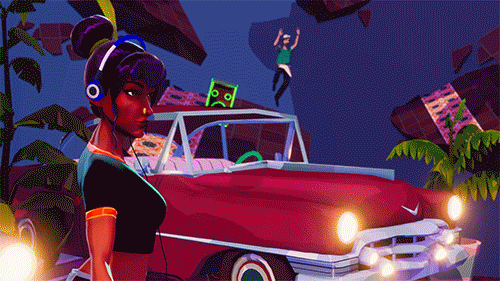
Turn-based, over-the-top combat with upgrades, special abilities, and a unique mood system that lets you take advantage of vulnerabilities. Take the fight to skate punks, random suitors, and ultimately, your exes.
Skateboarding
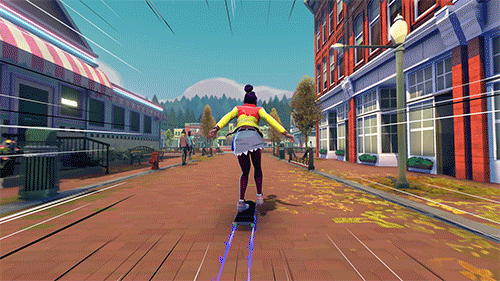
Skate, grind, and wall-run across Timber Hills with intricate movesets, combos, and challenges. Unravel the mysteries of Bearfoot Park while battling skate punks and their leader, Soundie the Bear.
Cooking
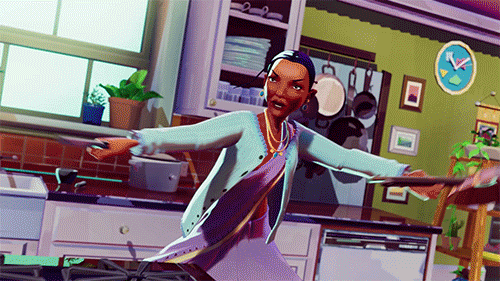
Try to impress your mom and repair your relationship with action-packed cooking segments, while exploring a rich menu of delicious South Asian inspired dishes.
44 notes
·
View notes
Photo

Falcon Age Spooky Bird Update 1.23 is Live on Steam and Epic!
Added Halloween items and decorations for a limited time Added inventory filtering by item type Added autosave during prison escape Added tutorial for using Spider Bots as bombs Changed inventory menu to update faster Made lighting transitions happen instantaneous when first loading a game Fixed some cases of Spider Bots becoming invulnerable Fixed headlock being jittery when using a mouse Fixed some visible seams in the terrain Fixed the button icon for Quit to Main Menu showing on menus where you can't use it Fixed some of the button icons for the Map being hidden Fixed Spanish translations of the Hunter objectives having the wrong count Fixed shadows not affecting effects when the Visual FX Quality was set to High Updated Map to be slightly sharper Updated objectives for Sandwolf Bones to use the correct item name Changed the Resolution option named "Eye Texture Scaling" to "VR Resolution Scale" to clarify its use Changed the bird command target icons (the triangle over an enemy) hide themselves in cases where your bird isn't listening to your commands Removed the Beet from Asoka's store, the last place it existed in the game Fixed farmed Turnips not being whippable Other misc bug fixes
5 notes
·
View notes
Text
Falcon Age 1.2 Big Bird Update on Switch, Steam, and Epic Store out now!
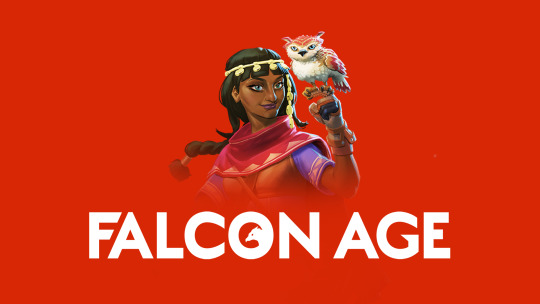
Switch and Steam Launch Trailer
We’ve added new content and modified a lot of the gameplay systems

STAT BUCKET SYSTEM
Complete overhaul of bird’s stat system
New “Stat Bucket System” based on combat usage not timers
Buffs feed into individual stat’s resource bucket that only drains with combat actions
Allows players to engage with hunting, cooking, and combat prep at their pace without ‘wasting’ resources
New clean UI to help convey amount of resources available, and showcase how much equipment is boosting it’s specific stats

To make this overhaul work we converted the timer based system into what we called the Stat Bucket system. Under this system all of the bird’s possible stats had its own “bucket”, that buff items like food would fill. As the player engaged in a specific combat mechanic, the associated Stat Bucket would use that resource. This had an immediate effect on combat encounters as the player could witness changes to the UI based on combat actions.
With this change the player could prepare food before an encounter and know they could flesh out a bird build without wasting resources, like in cases where enemies aren’t immediately in the entrance of an Outpost or Refinery. The second aspect of the Stat Bucket system is the ability to move the bottom of the bucket or “floor”, with bird equipment. This meant that through the game the player could accrue an assortment of equipment that would keep a specific Stat Bucket full to a certain level as long as the item was equipped. There are now a multitude of different endgame Bird Builds achievable that weren’t previously.
COMBAT ENCOUNTER REDESIGNS

Outposts updated to extend the exploration and combat period
Redesigns to better integrate the outposts into the games environmental storytelling
Combat flow reworked with new barriers, pathways, and enemy placement to add further tension to encounters
Through playtesting we found there were a few areas that were missing a little something, and had the opportunity to build out really dynamic and fun encounters. One of my main focuses at the time was looking at pre-existing assets and finding ways to rework them in these new encounters. Lets go over my favorite example, the Desert Outpost.
Looking through the assets used for the Desert Outpost, we found the scene used a larger concentration of steel boxes. This stood out and made the scene have a sense of being a storage encampment. The fact that this Outpost is on an isolated island with bridges for access meant we could lean heavily into this being a fortified cache. We moved the deactivator goal further from the initial walk area and erected massive walls. The first time you see them jutting out of the natural landscape you get the impulse to figure out what the Bots are hiding back there. The pathway to the Deactivator we built brings the player up in elevation to give the player a clear view of the storage crate combat maze ahead. This resulted in a new but familiar encounter that gives the player all the knowledge they need to quickly contain the problem.
The final results are combat encounters that feel familiar but refreshing and exhilarating.
Cooking Recipe & Food Redistribution
Redistribution of food items and treasures
Adjustment of status effect % for cooked foods
Recipe card redistributed through the world
Simplified food “tier” system for new bird stat system
Working with the narrative flow, combat flow and various systems wouldn’t be complete without a rework of the hunting and cooking systems. Cooking is one of the first systems the player is introduced to and is one of the pillars of the combat system. As we reworked combat encounters and world flow we found that the cooking system wasn’t matching the flow.
Ingredients and recipe cards needed to be more evenly distributed across the environment. How did we get in this pickle in the first place? Initial designs were that we wanted to have key vegetation locked behind completing each Refinery, that way there was direct content unlock after major progress. This helped the Refinery shutdowns have more impact on the systems, but meant that the world was empty of vegetation, due to the content gating. We had to weigh narrative impact against improving the overall world design, and found that integrating the vegetation across the world made it feel much more lived in.
Now that we had a more vibrant world that the player could more freely engage with and experiment with, we had to ensure that the player was being more evenly drip fed recipe cards. Recipe cards are actually optional and not needed for cooking, as the player can stumble into recipes through experimentation. Still we needed to make sure recipes that had impact for the player in that moment were accessible. Another aspect of redistributing vegetation and recipe cards properly was how it would feed into the new stat system.
Food items have been completely redesigned for this update. After redistributing and trimming the recipes and ingredients in the world we studied how players would use the food items, which ones were most likely to be made and how well the buffs were conveyed. We found that food items as a whole were not engaged with on the level we were hoping for, as players found the timed effects to be quickly wasted. It was easier for some players to just ignore the system entirely, due to lack of clarity and quick buff drains.
Now that we had a cooking system which was easier to engage with, we wanted to ensure the player could more easily parse the How, When & Why of the buff items that resulted as well. Food items originally used a short timer and a multitude of different “levels” for the percentage amount of stat buff the bird got from the item. We wanted to simplify the Stat Buff system and have player decisions have a greater effect for longer stretches of combat, instead of bursts of stat improvement in small sections.
Quest Additions and Changes
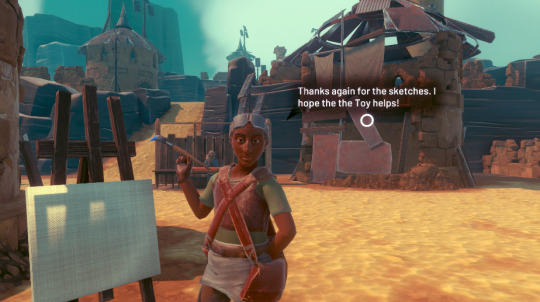
Additional NPC dialog across the board focusing on furthering the lore of the game, detailing more about the characters’ history and perspectives on current events
New quest with The Painter that explores new bespoke areas known as Landmarks
Further integration of fauna hunting with player progress and bird growth through a whole new quest NPC, The Hunter
For this update we wanted to take the time to further explore how the individual elements of the world fit together. The world is full of fun and charming NPCs with their own perspectives and interests. One of our favorites is the climber character who challenges the player and their bird to a timed challenge. We love how the environment, the player and the characters are all connected into a bespoke experience.
In this update we expanded on a handful of NPC quests to make them more bespoke and further integrated into the world around them. Often this is in direct response to additions and changes we made to the world. The best example of this is the new NPC, The Hunter. They’re very interested in your bird and see an opportunity to help hone her skills through challenges. The player can gain very powerful training gear and lots of fauna materials by defeating The Hunter’s many dangerous challenges.
Steam:
https://store.steampowered.com/app/1075080/Falcon_Age/
Switch:
https://www.nintendo.com/games/detail/falcon-age-switch/
22 notes
·
View notes
Text
Porting Falcon Age to the Oculus Quest

There have already been several blog posts and articles on how to port an existing VR game to the Quest. So we figured what better way to celebrate Falcon Age coming to the Oculus Quest than to write another one!
So what we did was reduced the draw calls, reduced the poly counts, and removed some visual effects to lower the CPU and GPU usage allowing us to keep a constant 72 hz. Just like everyone else!
Thank you for coming to our Tech talk. See you next year!
...
Okay, you probably want more than that.
Falcon Age
So let's talk a bit about the original PlayStation VR and PC versions of the game and a couple of the things we thought were important about that experience we wanted to keep beyond the basics of the game play.
Loading Screens Once you’re past the main menu and into the game, Falcon Age has no loading screens. We felt this was important to make the world feel like a real place the player could explore. But this comes at some cost in needing to be mindful of the number of objects active at one time. And in some ways even more importantly the number of objects that are enabled or disabled at one time. In Unity there can be a not insignificant cost to enabling an object. So much so that this was a consideration we had to be mindful of on the PlayStation 4 as loading a new area could cause a massive spike in frame time causing the frame rate to drop. Going to the Quest this would be only more of an issue.
Lighting & Environmental Changes While the game doesn’t have a dynamic time of day, different areas have different environmental setups. We dynamically fade between different types of lighting, skies, fog, and post processing to give areas a unique feel. There are also events and actions the player does in the game that can cause these to happen. This meant all of our lighting and shadows were real time, along with having custom systems for handling transitioning between skies and our custom gradient fog.
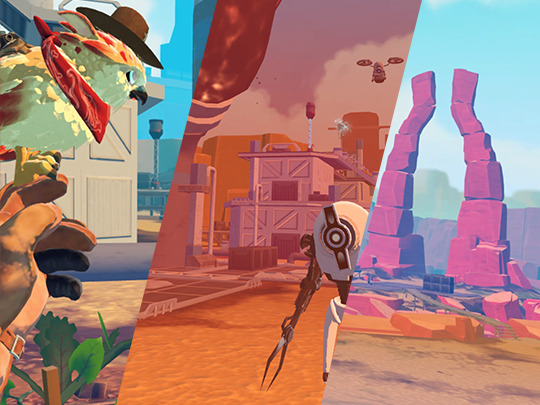
Our skies are all hand painted clouds and horizons cube maps on top of Procedural Sky from the asset store that handles the sky color and sun circle with some minor tweaks to allow fading between different cube maps. Having the sun in the sky box be dynamic allowed the direction to change without requiring totally new sky boxes to be painted.
Our gradient fog works by having a color gradient ramp stored in a 1 by 64 pixel texture that is sampled using spherical distance exp2 fog opacity as the UVs. We can fade between different fog types just by blending between different textures and sampling the blended result. This is functionally similar to the fog technique popularized by Campo Santo’s Firewatch, though it is not applied as a post process as it was for that game. Instead all shaders used in the game were hand modified to use this custom fog instead of Unity’s built in fog.
Post processing was mostly handled by Unity’s own Post Processing Stack V2, which includes the ability to fade between volumes which the custom systems extended. While we knew not all of this would be able to translate to the Quest, we needed to retain as much of this as possible.
The Bird At its core, Falcon Age is about your interactions with your bird. Petting, feeding, playing, hunting, exploring, and cooperating with her. One of the subtle but important aspects of how she “felt” to the player was her feathers, and the ability for the player to pet her and have her and her feathers react. She also has special animations for perching on the player’s hand or even individual fingers, and head stabilization. If at all possible we wanted to retain as much of this aspect of the game, even if it came at the cost of other parts.
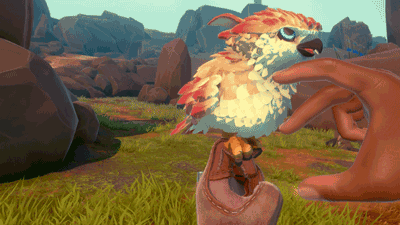
You can read more about the work we did on the bird interactions and AI in a previous dev blog posts here: https://outerloop.tumblr.com/post/177984549261/anatomy-of-a-falcon
Taking on the Quest
Now, there had to be some compromises, but how bad was it really? The first thing we did was we took the PC version of the game (which natively supports the Oculus Rift) and got that running on the Quest. We left things mostly unchanged, just with the graphics settings set to very low, similar to the base PlayStation 4 PSVR version of the game.
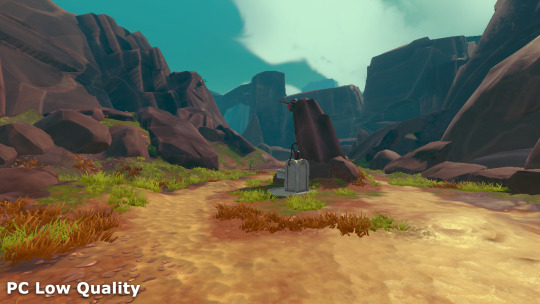
It ran at less than 5 fps. Then it crashed.
Ooph.
But there’s some obvious things we could do to fix a lot of that. Post processing had to go, just about any post processing is just too expensive on the Quest, so it was disabled entirely. We forced all the textures in the game to be at 1/8th resolution, that mostly stopped the game from crashing as we were running out of memory. Next up were real time shadows, they got disabled entirely. Then we turned off grass, and pulled in some of the LOD distances. These weren’t necessarily changes we would keep, just ones to see what it would take to get the performance better. And after that we were doing much better.
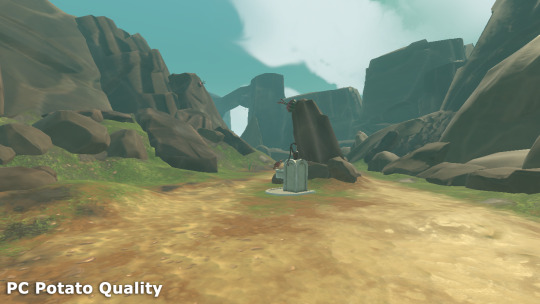
A real, solid … 50 fps.
Yeah, nope.
That is still a big divide between where we were and the 72 fps we needed to be at. It became clear that the game would not run on the Quest without more significant changes and removal of assets. Not to mention the game did not look especially nice at this point. So we made the choice of instead of trying to take the game as it was on the PlayStation VR and PC and try to make it look like a version of that with the quality sliders set to potato, we would need to go for a slightly different look. Something that would feel a little more deliberate while retaining the overall feel.
Something like this.
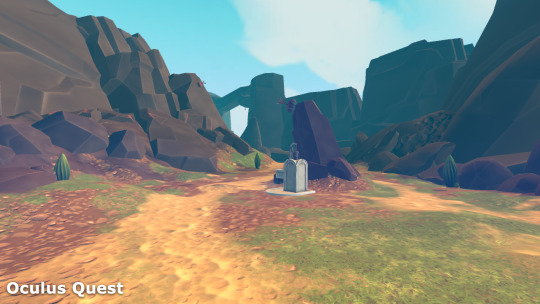
Optimize, Optimize, Optimize (and when that fails delete)
Vertex & Batch Count
One of the first and really obvious things we needed to do was to bring down the mesh complexity. On the PlayStation 4 we were pushing somewhere between 250,000 ~ 500,000 vertices each frame. The long time rule of thumb for mobile VR has been to be somewhere closer to 100,000 vertices, maybe 200,000 max for the Quest.
This was in some ways actually easier than it sounds for us. We turned off shadows. That cut the vertex count down significantly in many areas, as many of the total scene’s vertex count comes from rendering the shadow maps. But the worse case areas were still a problem.
We also needed to reduce the total number of objects and number of materials being used at one time to help with batching. If you’ve read any other “porting to Quest” posts by other developers this is all going to be familiar.

This means combining textures from multiple object into atlases and modifying the UVs of the meshes to match the new position in the atlas. In our case it meant completely re-texturing all of the rocks with a generic atlas rather than having every rock use a custom texture set.
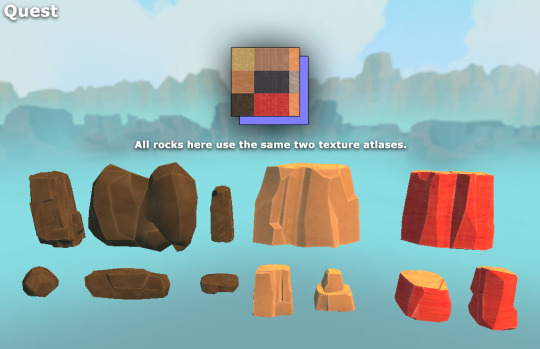
Now you might think we would want also reduce the mesh complexity by a ton. And that’s true to an extent. Counter intuitively some of the environment meshes on the Quest are more complex than the original version. Why? Because as I said we were looking to change the look. To that end some meshes ended up being optimized to far low vertex counts, and others ended up needing a little more mesh detail to make up for the loss in shading detail and unique texturing. But we went from almost every mesh in the game having a unique texture to the majority of environment objects sharing a small handful of atlases. This improved batching significantly, which was a much bigger win than reducing the vertex count for most areas of the game.
That’s not to say vertex count wasn’t an issue still. A few select areas were completely pulled out and rebuilt as new custom merged meshes in cases where other optimizations weren’t enough. Most of the game’s areas are built using kit bashing, reusing sets of common parts to build out areas. Parts like those rocks above, or many bits of technical & mechanical detritus used to build out the refineries in the game. Making bespoke meshes let us remove more hidden geometry, further reduce object counts, and lower vertex counts in those problem areas.

We also saw a significant portion of the vertex count coming from the terrain. We are using Unity’s built in terrain system. And thankfully we didn’t have to start from total scratch here as simply increasing the terrain component's Pixel Error automatically reduces the complexity of the rendered terrain. That dropped the vertex count even more getting us closer to the target budget without significantly changing the appearance of the geometry.

After that many smaller details were removed entirely. I mentioned before we turned off grass entirely. We also removed several smaller meshes from the environment in various places where we didn’t think their absence would be noticed. As well as removed or more aggressively disabled out of view NPCs in some problem areas.
Shader Complexity
Another big cost was most of the game was using either a lightly modified version of Unity’s Standard shader, or the excellent Toony Colors Pro 2 PBR shader. The terrain also used the excellent and highly optimized MicroSplat. But these were just too expensive to use as they were. So I wrote custom simplified shaders for nearly everything.
The environment objects use a simplified diffuse shading only shader. It had support for an albedo, normal, and (rarely used) occlusion texture. Compared to how we were using the built in Standard shader this cut down the number of textures a single material could use by more than half in some cases. This still had support for the customized gradient fog we used throughout the game, as well as a few other unique options. Support for height fog was built into the shader to cover a few spots in the game where we’d previously used post processing style methods to achieve. I also added support for layering with the terrain’s texture to hide a few places where there were transitions from terrain to mesh.

Toony Colors Pro 2 is a great tool, and is deservedly popular. But the PBR shader we were using for characters is more expensive than even the Standard shader! This is because the way it’s implemented is it’s mostly the original Standard Shader with some code on top to modify the output. Toony Colors Pro 2 has a large number of options for modifying and optimizing what settings to use. But in the end I wrote a new shader from scratch that mimicked some of the aspects we liked about it. Like the environment shader it was limited to diffuse shading, but added a Fresnel shine.

The PSVR and PC terrain used MicroSplat with 12 different terrain layers. MicroSplat makes these very fast and much cheaper to render than the built in terrain rendering. But after some testing we found we couldn’t support more than 4 terrain layers at a time without really significant drops in performance. So we had to go through and completely repaint the entire terrain, limiting ourselves to only 4 texture layers.
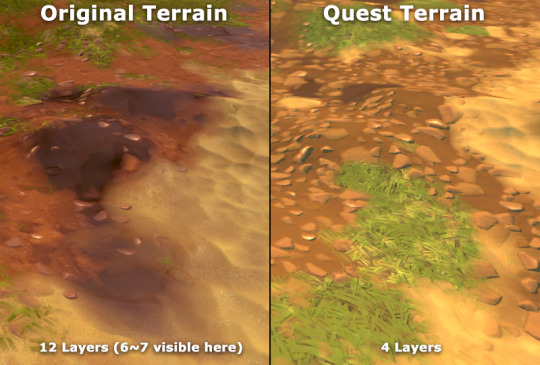
Also, like the other shaders mentioned above, the terrain was limited to diffuse only shading. MicroSplat’s built in shader options made this easy, and apart from the same custom fog support added for the original version, it didn’t require any modifications.
Post Processing, Lighting, and Fog
The PSVR and PC versions of Falcon Age makes use of color grading, ambient occlusion, bloom, and depth of field. The Quest is extremely fill rate limited, meaning full screen passes of anything are extremely expensive, regardless of how simple the shader is. So instead of trying to get this working we opted to disable all post processing. However this resulted in the game being significantly less saturated. And in extreme cases completely different. To make up for this the color of the lighting and the gradient fog was tweaked to make up for this. This is probably the single biggest factor in the overall appearance of the original versions of the game and the Quest version not looking quite the same.
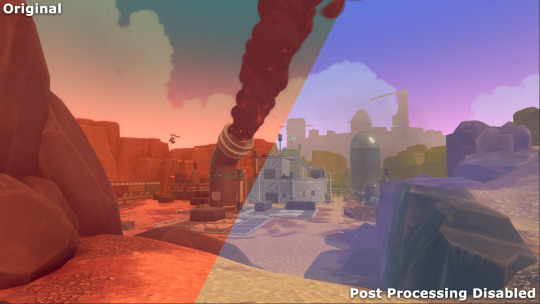
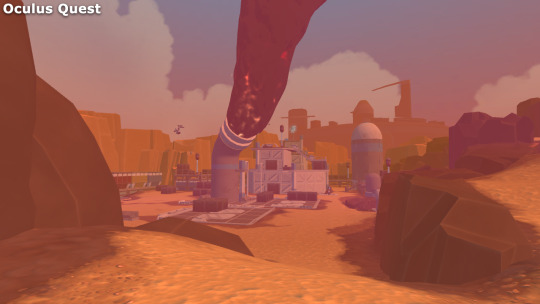
Also as mentioned before we disabled real time shadows. We discussed doing what many other games have done which is move to baked lighting, or at least pre-baked shadows. We decided against this for a number of reasons. Not the least of which was our game is mostly outdoors so shadows weren’t as important as it might have been for many other games. We’ve also found that simple real time lighting can often be faster than baked lighting, and that certainly proved to be true for this game.
However the lack of shadows and screen space ambient occlusion meant that there was a bit of a disconnect between characters in the world and the ground. So we added simple old school blob shadows. These are simple sprites that float just above the terrain or collision geometry, using a raycast from a character’s center of mass, and sometimes from individual feet. There’s a small selection of basic blob shapes and a few unique shapes for certain feet shapes to add a little extra bit of ground connection. These are faded out quickly in the distance to reduce the number of raycasts needed.

Falcon
Apart from the aforementioned changes to the shading, which was also applied to the falcon’s custom shaders, we did almost nothing to the bird. All the original animations, reaction systems, and feather interactions remained. The only thing we did to the bird was simplify a few of the bird equipment and toy models. The bird models themselves remained intact.
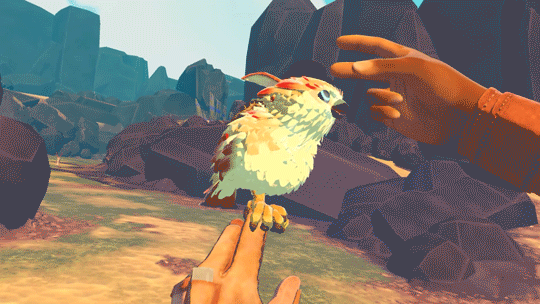
I did say we thought this was important at the start. And we early on basically put a line in the sand and said we were going to keep everything enabled on the bird unless absolutely forced to disable it.
There was one single sacrifice to the optimization gods we couldn’t avoid though. That’s the trails on the bird’s wings. We were making use of Ara Trails, which produce very high quality and configurable trails with a lot more control than Unity’s built in systems. These weren’t really a problem for rendering on the GPU, but CPU usage was enough that it made sense to pull them.
Selection Highlights
This is perhaps an odd thing to call out, but the original game used a multi pass post process based effect to draw the highlight outlines on objects for both interaction feedback and damage indication. These proved to be far too expensive to use on the Quest. So I had to come up with a different approach. Something like your basic inverted shell outline, like so many toon stylized games use, would seem like the perfect approach. However we never built the meshes to work with that kind of technique, and even though we were rebuilding large numbers of the meshes in the game anyway, some objects we wanted to highlight proved difficult for this style of outline.
With some more work it would have been possible to make this an option. But instead I found an easier to implement approach that, on the face, should have been super slow. But it turns out the Quest is very efficient at handling stencil masking. This is a technique that lets you mark certain pixels of the screen so that subsequent meshes being rendered can ask to not be rendered in. So I render the highlighted object 6 times! With 4 of those times slightly offset in screen space in the 4 diagonal directions. The result is a fairly decent looking outline that works on arbitrary objects, and was cheap enough to be left enabled on everything that it had been on before, including objects that might cover the entire screen when being highlighted.
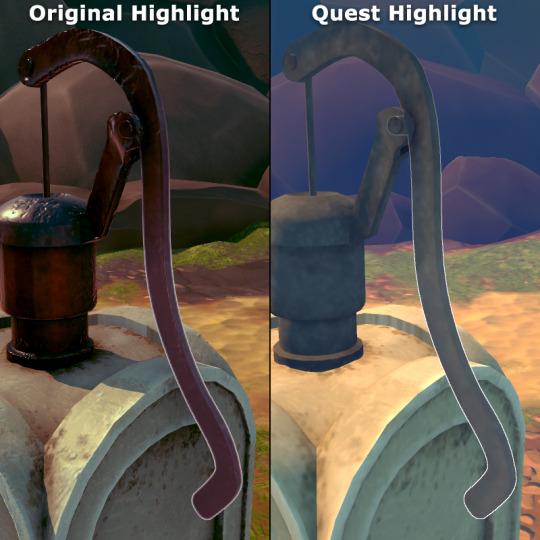
Particles and General VFX
For the PSVR version of the game, we already had two levels of VFX in the game to support the base Playstation 4 and Playstation 4 Pro with different kinds of particle systems. The Quest version started out with these lower end particle systems to begin with, but it wasn’t enough. Across the board the number and size of particles had to be reduced. With some effects removed or replaced entirely. This was both for CPU performance as the sheer number of particles was a problem and GPU performance as the screen area the particles covered became a problem for the Quest’s reduced fill rate limitations.
For example the baton had an effect that included a few very simple circular glows on top of electrical arcs and trailing embers. The glows covered enough of the screen to cause a noticeable drop in framerate even just holding it by your side. Holding it up in front of your face proved too expensive to keep framerate in even the simplest of scenes.
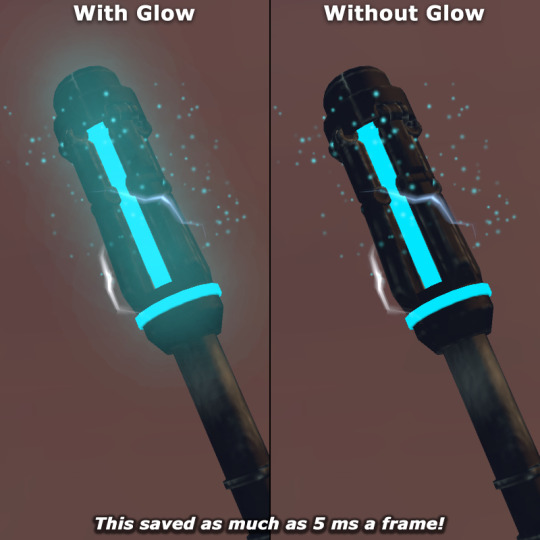
Similar the number of embers had to be reduced to improve the CPU impact. The above comparison image only shows the removal of the glow and already has the reduced particle count applied.
Another more substantive change was the large smoke plumes. You may have already noticed the difference in some of the previous comparisons above. In the original game these used regular sprites. But even reducing the particle count in half the rendering cost was too much. So these were replaced with mesh cylinders using a shader that makes them ripple and fade out. Before changing how they were done the areas where the smoke plumes are were unable to keep the frame rate above 72 fps any time they were in view. Sometimes dipping as low as 48 hz. Afterwards they ceased to be a performance concern.

Those smoke plumes originally made use of a stylized smoke / explosion effect. That same style of effect is reused frequently in the game for any kind of smoke puff or explosion. So while they were removed for the smoke stacks, they still appeared frequently. Every time you take out a sentry or drone your entire screen was filled with these smoke effects, and the frame rate would dip below the target. With some experimentation we found that counter to a lot of information out there, using alpha tested (or more specifically alpha to coverage) particles proved to be far more efficient to render than the original alpha blended particles with a very similar overall appearance. So that plus some other optimizations to those shaders and the particle counts of those effects mean multiple full screen explosions did not cause a loss in frame rate.
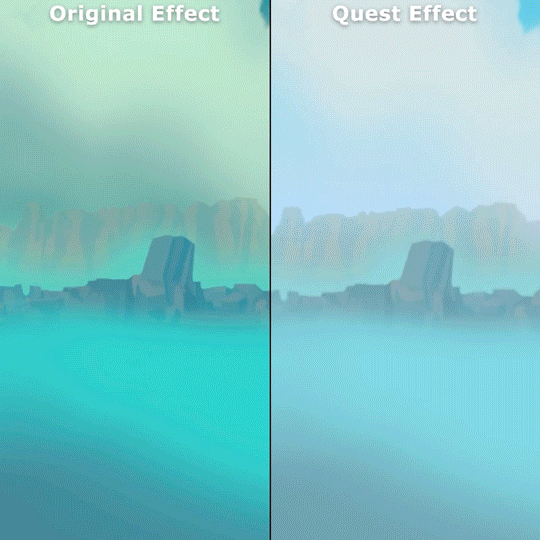
The two effects are virtually identical in appearance, ignoring the difference in lighting and post processing. The main difference here is the Quest explosion smoke is using dithered alpha to coverage transparency. You can see if you look close enough, even with the gif color dithering.
Success!
So after all that we finally got to the goal of a 72hz frame rate! Coming soon to an Oculus Quest near you!
https://www.oculus.com/experiences/quest/2327302830679091/
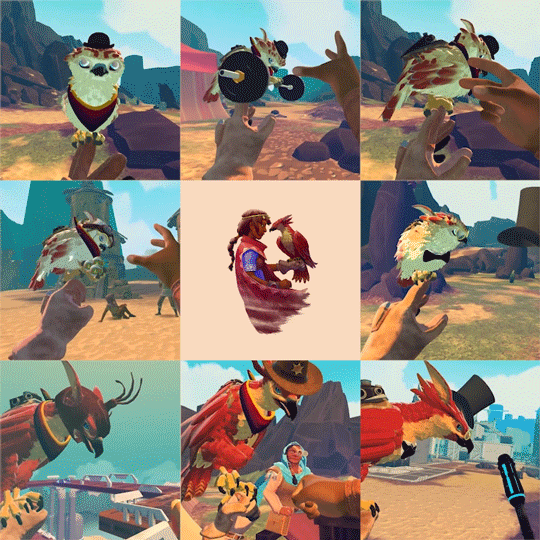
10 notes
·
View notes
Photo

We’re getting things ready to launch Falcon Age on the Epic Games Store. In the meantime, we’re inviting folks to join our community Discord! If you’d like to check out the game early by taking part in a Beta test, info is in our Discord
593 notes
·
View notes
Video
tumblr
Another Falcon Age update is live!
Added a little hammer toy
Fixed a falcon name save issue
Ara lowers her arm while walking with adult falcon for better visibility
UI fix for filtering plantable items
36 notes
·
View notes
Video
tumblr
Falcon Age update is live on PS4!
New game/control options:
Option to swap which hand does locomotion and bird pointer
Toggle headbob on/off
Toggle for motion controlled hand launching of falcon which prevents falcon from taking off due to quick hand motion
Toggle for bird health HUD indicator
Maximum turn speed sliders for non-VR
Separate control options into VR and non-VR sections, gray out options that do not apply to current VR and control modes
Fix for bird not staying on hand during smooth VR motion
New Cosmetic Items
A new skateboard with new tricks for bird
YoYo for bird
Sunglasses for bird
Auntie’s goggles for bird
NPC-style goggles for bird
Baseball cap for bird
Ear Flap hat for bird
Pirate hat for bird
Horned Helmet for bird
Gameplay
Added helper objective to direct the player back to bed in the tutorial sequence
Adjust collect robot parts objective target position and add an additional parts chest that activates with the objective
Add indicator for farm debris to make it easier to identify
Bird will take an offered bomb from the player’s hand without having to release trigger when using motion controls
Enlarge the area the player can stand in to activate foldable bridge jab switches and tie the control hint to that same trigger
Stepping into a mine while it is being dug out will no longer freeze the player’s movement on respawn
Motion control fistbump/handshake will work reliably on game reload
After making it to Refinery Uda, a clear path will permanently open up in the preceding minefield
Added autosave just prior to entering Port Loop
Adult and baby bird health now transfer when changing birds
Add dot over beret and hang it on a monitor to make it easier to spot
Save tent bed state
Fix some recipes and recipe card issues
Skipping the first talk to resistance member objective and talking to Auntie will now clear the objective
Enemies
Added stun animation to heavy sentry
Added hit react animations to alarm drones
Add additional time where shock sentries do not hurt the player when struck during their recovery animations
Leash the town outpost drones to the outpost area so they will not chase the player into town
Controls
Add additional downforce to player to stick to steep ramps better
Left Move Controller triangle button can be used to whistle for the bird without doing the whistle motion
Increase auto aim for bird pointer and whip
Increase tolerance for close-up whipping
Reset camera pitch when starting sandstorm cutscene in non-vr
Save point fountains require only one press of X to activate
Other
Naming the bird applies the name to the bird’s bells and starter leather
Fixes for typos in game text and trophy pack
Adjusted canyon area to reduce pop in of canyon terrain
Detach whip tip from jab switches destroyed by bombs
Adjust charisma text to be more explicit about what it does
Updated credits
Updated tutorial graphics
20 notes
·
View notes
Video
tumblr
Baby falcon headlock in non-VR and VR
46 notes
·
View notes
Photo

Baby’s first sketchbook
299 notes
·
View notes
Video
tumblr
Birds are just like humans. Humans who do tricks and happen to animate birds doing the same.
19 notes
·
View notes
Video
tumblr
Baby falcon twist!
21 notes
·
View notes